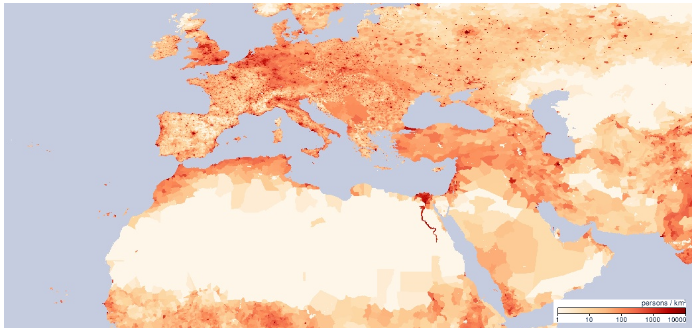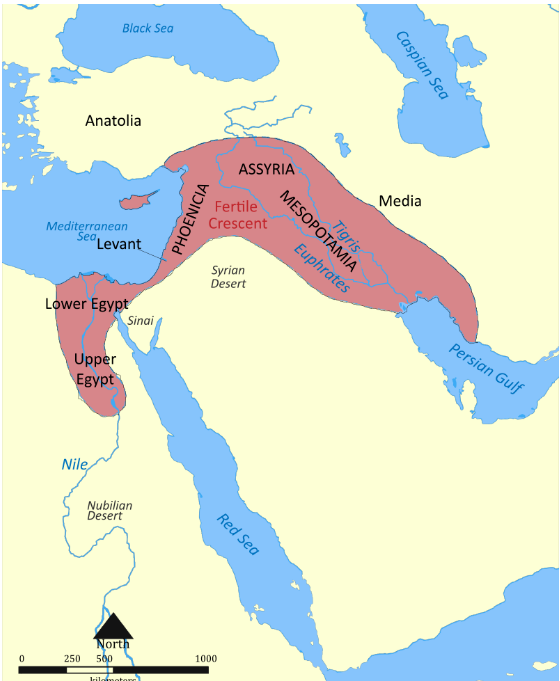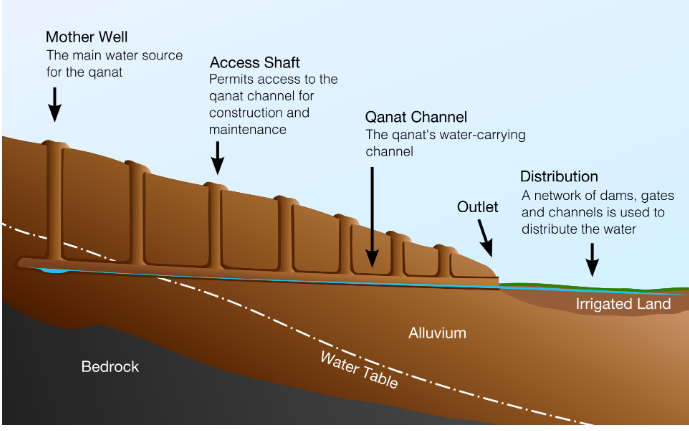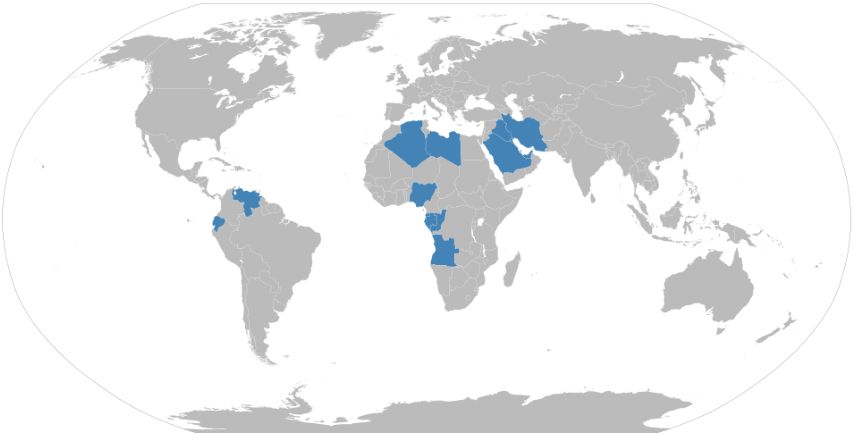7.2: Cultural Adaptations in North Africa and Southwest Asia
- Page ID
- 21089
The climate and physical geography of North Africa and Southwest Asia have shaped population patterns and culture in the region. People in the region are generally clustered around the region’s sparse water resources reflecting ancient patterns of human settlement (Figure \(\PageIndex{1}\)). Four regions in particular stand out as having high population densities: the Nile River valley, the coastal Mediterranean Sea, the Euphrates and Tigris river basins, and valleys of northwestern Iran.

Over 10,000 years ago, the earliest humans in North Africa and Southwest Asia settled in the Fertile Crescent, the area surrounding the Tigris, Euphrates, and Nile rivers (Figure \(\PageIndex{2}\)). Here, humans first domesticated crops and animals and created the first farming settlements. In Mesopotamia, in particular, the river valley of the Tigris and Euphrates, innovations occurred that would change the trajectory of human existence. This was where the wheel was first invented, the first system of mathematics was created, and the first cereal crops, such as barley and wheat, were planted. Mesopotamia was also the site of the first urban civilization, called Sumer. Uruk, a city of Sumer, had a population of over 50,000 people by 2500 BCE making it the most populous city in the world at the time. The ancient city of Babylon, located between the Tigris and Euphrates, was inhabited for thousands of years and was likely the first city to reach a population of 200,000.

The people of this region have developed a number of adaptations to living in such a dry climate. Buildings are commonly designed with high roofs. Since hot air rises, having a higher ceiling allows the living area to remain relatively cool. Rooms are also often arranged around a common, shaded courtyard. This allows for maximum privacy, but also provides air flow throughout the living spaces. The traditional style of dress in parts of this region is also distinctive and reflects the physical landscape. Men might wear a cotton headdress to provide protection from the sand and sun as well as a long, flowing robe. Women’s traditional clothing in the region is more reflective of religious values than environmental factors.
For some cultural groups in the region, adapting to the physical environment means migrating to cooler areas during the hottest parts of the year. The Berbers, for example, an indigenous group in North Africa, traditionally herd livestock and migrate seasonally seeking water, grazing land, and shelter. However, the way of life for many pastoral nomads in this region, like some Berbers, has changed significantly in recent years. Many governments have encouraged these groups to practice settled agriculture rather than seasonal migration, and international boundaries have often cut off traditional migratory paths.
The Persians, from modern-day Iran, devised an innovative way to transport water known as a qanat. Qanats are underground tunnels used to extract groundwater from below mountains and transport it downhill, where it is used to irrigate cropland (Figure \(\PageIndex{3}\)). They were developed over 2,500 years ago and many old qanats are still in use today in Iran as well as Afghanistan.

In such a harsh, arid environment, agricultural potential is fairly limited. River valleys and coastal areas provided small stretches of fertile land, but in the absence of widespread agricultural development, what other resources could bring this region wealth? In the early 20th century, oil was discovered in Saudi Arabia and this natural resource would prove both a blessing and a curse to the region.
Today, Saudi Arabia remains the world’s leading oil exporter, shipping over 7.3 million barrels per day as of 2015. Kuwait, Iran, Iraq, and the United Arab Emirates are also among the top seven global oil exporters. Oil revenues have been able to increase development in these countries, financing industrialization, infrastructure, and providing high incomes. Qatar, for example, a small, former British protectorate on the coast of the Arabian Peninsula, has the highest GDP per capita in terms of purchasing power parity of any country in the world (as of 2018, according to the International Monetary Fund), at over $130,000 per person, largely due to its expansive oil and natural gas reserves. The tallest building in the world is now the Burj Khalifa, located in Dubai, United Arab Emirates. Although the United Arab Emirates, in building this 828 meter (2,717 feet) marvel, is seeking to diversify its economy and gain international recognition, its economy is still heavily dependent on oil.
Countries in the developing world with oil resources have often been prone to authoritarian rule, slow growth, corruption, and conflict. Oil wealth has been used to finance armies, and corrupt governments have pocketed oil revenue rather than reinvesting it in social programs or infrastructure. Furthermore, placing such a high emphasis on exporting one resource, like oil, has made this region vulnerable to changes in global energy demand. In 2015, countries in North Africa and Southwest Asia lost $390 billion in revenue due to low oil prices.
In an effort to coordinate oil production and prices, five countries including Venezuela, Iran, Iraq, Kuwait, and Saudi Arabia formed the Organization of the Petroleum Exporting Countries (OPEC) in 1960. Today, OPEC has 14 member states and covers over 40 percent of global oil exports (Figure \(\PageIndex{4}\)). OPEC cooperatively determines how much oil to produce and collectively bargains for the price of oil, rather than trying to compete to undercut one another. The United States and other countries have increased their own domestic oil production in recent years, causing OPEC’s global share of oil exports to decline.

The presence of oil has also left a colonial legacy across North Africa and Southwest Asia, and has made these countries vulnerable to foreign control and influence. In addition, the uneven distribution of oil resources and wealth has led to inequality both within and between countries. Ethnic inequalities have also emerged as groups have uneven access to oil reserves and income. Oil has also changed the pattern of human settlement in the region by bringing in migrants from outside the realm attracted by the prospect of economic opportunity.
- Fertile Crescent:
-
an early area of human civilization in North Africa and Southwest Asia surrounding the Tigris, Euphrates, and Nile rivers
- Qanat:
-
a system of irrigation first developed in modern-day Iran consisting of an underground tunnel used to extract groundwater from below mountains and transport it downhill


